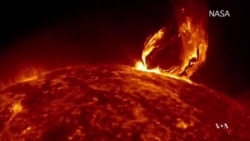Scientists who study the sun watch for sunspots -- violent storms that can affect communications, navigation systems and even electric power stations on Earth.
One of those scientists is Alex Young of the Goddard Space Flight Center in Greenbelt, Maryland. Crews at Goddard are studying the Earth and our solar system for NASA, the National Aeronautics and Space Administration. Mr. Young recently told VOA what the space agency is learning about the sun.
Sunspots are a product of huge electromagnetic storms on the sun. Scientists on Earth are able to observe sunspots eight minutes after they happen. That is how long it takes for the sun’s light to reach us.
The first electrically charged particles from a sunspot enter Earth’s atmosphere about 20 to 30 minutes after the storm happens. These particles can harm human beings. So before they arrive, astronauts on the International Space Station move into special areas designed to protect them from their effects.
About a day or two later, the biggest part of the storm arrives. It is called a coronal mass ejection.
“That is billions of tons of solar material that’s blown away from the sun. (When) it’s traveling millions of kilometers an hour, but that is relatively slow.”
That is Alex Young. He is the Associate Director for Science at NASA’s Heliophysics Science Division.
Several civilian government agencies and the U.S. Air Force watch weather conditions in space 24 hours a day. NASA does so because it must protect its astronauts and the electronic devices on its spacecraft.
Scientists are also trying to understand why the number of sunspots rises and falls at almost regular intervals every 11 years. In other words, scientists can almost predict the amount of solar activity.
“Also, sometimes the intensity is higher, sometimes lower. For example, the current solar cycle, as we call it, that we are in, is much lower than the previous one.”
Several satellites watch the sun and the environment between the sun and the earth. Pictures and other information from the satellites tell scientists what is happening on and near the sun.
Alex Young says we have only been looking at the sun with powerful instruments for about 30 to 40 years. That is a very short time compared to the four billion years that the star has been shining.
I’m Jim Tedder.
VOA’s George Putic reported this story from Washington. Christopher Jones-Cruise adapted it for Learning English. George Grow was the editor.
______________________________________________________________
Words in This Story
navigation – n. the act, activity or process of finding the way to get to a place when traveling
electromagnetic – adj. relating to electromagnetism, the study of a kind of physical interaction that takes place between electrically charged particles
relatively – adv. when compared to others
cycle – n. a series of events or actions that happen again and again in the same order; a repeating series of events or actions
Have sunspots affected communications, navigation or electric power in your country? We want to hear from you. Write your thoughts in the comments section.





